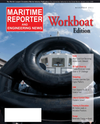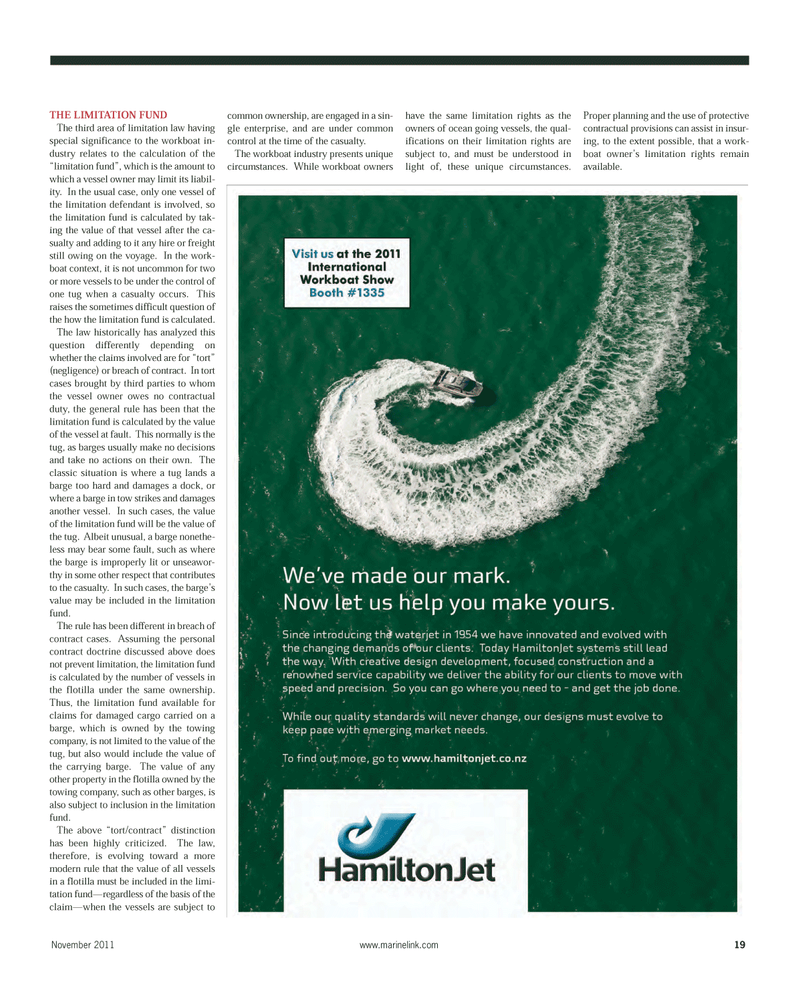
Page 19: of Maritime Reporter Magazine (November 2011)
Feature: Workboat Annual
Read this page in Pdf, Flash or Html5 edition of November 2011 Maritime Reporter Magazine
November 2011www.marinelink.com 19THE LIMITATION FUND The third area of limitation law having special significance to the workboat in- dustry relates to the calculation of the?limitation fund?, which is the amount towhich a vessel owner may limit its liabil- ity. In the usual case, only one vessel of the limitation defendant is involved, so the limitation fund is calculated by tak-ing the value of that vessel after the ca- sualty and adding to it any hire or freight still owing on the voyage. In the work- boat context, it is not uncommon for two or more vessels to be under the control of one tug when a casualty occurs. This raises the sometimes difficult question of the how the limitation fund is calculated. The law historically has analyzed this question differently depending on whether the claims involved are for ?tort? (negligence) or breach of contract. In tort cases brought by third parties to whomthe vessel owner owes no contractual duty, the general rule has been that the limitation fund is calculated by the value of the vessel at fault. This normally is the tug, as barges usually make no decisions and take no actions on their own. The classic situation is where a tug lands abarge too hard and damages a dock, or where a barge in tow strikes and damages another vessel. In such cases, the value of the limitation fund will be the value of the tug. Albeit unusual, a barge nonethe- less may bear some fault, such as where the barge is improperly lit or unseawor- thy in some other respect that contributes to the casualty. In such cases, the barge?s value may be included in the limitation fund.The rule has been different in breach of contract cases. Assuming the personal contract doctrine discussed above does not prevent limitation, the limitation fund is calculated by the number of vessels in the flotilla under the same ownership. Thus, the limitation fund available for claims for damaged cargo carried on a barge, which is owned by the towing company, is not limited to the value of the tug, but also would include the value of the carrying barge. The value of any other property in the flotilla owned by the towing company, such as other barges, is also subject to inclusion in the limitationfund. The above ?tort/contract? distinction has been highly criticized. The law, therefore, is evolving toward a more modern rule that the value of all vessels in a flotilla must be included in the limi-tation fund?regardless of the basis of the claim?when the vessels are subject to common ownership, are engaged in a sin- gle enterprise, and are under commoncontrol at the time of the casualty. The workboat industry presents unique circumstances. While workboat owners have the same limitation rights as the owners of ocean going vessels, the qual- ifications on their limitation rights are subject to, and must be understood inlight of, these unique circumstances.Proper planning and the use of protective contractual provisions can assist in insur- ing, to the extent possible, that a work- boat owner?s limitation rights remain available. MR Nov.11 # 3 (18-24):MR Template 10/31/2011 9:00 AM Page 19

 18
18

 20
20
